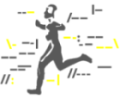





Search | Sitemap | Navigation |  |
|
||||||||||||||||||||||||||
|
||||||||||||||||||||||||||
|
||||||||||||||||||||||||||
|
| Migraine Art in the Internet |
Further Competitions Inspired by the Migraine Art Concept
The concept of Migraine Art inspired a number of subsequent art contests organized by various parties in the United States and the UK.

Logo of the National Headache Foundation. © 2004 National Headache Foundation
The National Headache Foundation has organized, under grants supplied by Wyeth-Ayerst Laboratories, Abbott Laboratories, Pfizer Inc., and Ortho-McNeil Pharmaceutical Inc., four 'Migraine Masterpieces' art competitions performed in 1988/89, 1997/98, 2001, and 2003.

Peter Gachot, Man with Migraine, 1989. (Entry to the First Migraine Masterpieces art contest.) © 2004 National Headache Foundation (Lost webpage http://home.inreach.com/ptglmn/art3.htm, August 14, 2003)
|
Peter Gachot's "'Man with Migraine' illustrates the artist's experience with migraine highlighting the loss of strength, where the simplest task − like taking medication − is overwhelmingly taxing and the pain is dishevelling." [more] (Cited from ‘Migraine Masterpiece‘ exhibit, List of works, National Headache Foundation 1989) |

Rick Hutchinson, Migraine Five; We're in Pain, 1989. (Entry to the First Migraine Masterpieces art contest.) © 2004 National Headache Foundation
|
Rick Hutchinson's "'Migraine Five; We're in Pain' depicts the various stages and progressions of pain the artist experiences during a migraine attack. These stages are represented by: impaired vision (the blue creatures or spots), piercing pain in the eye (needle), numb or heavy hands (as if of stone), sharp, throbbing pain in the temples (pick-axe), pressure pain throughout the rest of the head (vice), amplified pain caused by the slightest movement, sound or light (barbed wire)." (Cited from 'Migraine Masterpiece' exhibit, List of works, National Headache Foundation 1989) |
A press release promoting the first contest stated: "The purpose of the Migraine Masterpieces Competition, an idea that originated in Europe, is to educate others about the 'severity of migraine pain.' All entries must be a vivid interpretation of the pain of your migraine." The second contest saw a shift of theme, its purpose being "to educate others about the benefits of migraine prevention. All entries must communicate the impact of frequent migraines on the sufferer's lifestyle and/or family and friends." The third contest, themed 'Images of Migraine', called participants "to depict their world when dealing with a migraine". The fourth contest, entitled 'My Life With Migraine', required sufferers "to artistically represent their world as it is affected by migraine".
Missing Remotes and Migraine MasterpiecesBy Roy RivenburgQuestion: As an artist, I strive to create paintings that convey a pulsating or throbbing pain, visual disturbances and nausea or vomiting. Is there a market for my work? © 2001 Roy Rivenburg (www.offkilter.org/feb142001.html, June 5, 2004) |
The four competitions drew circa 400, 151, circa 210 and more than 400 entries, respectively. Selected entries to the 'Migraine Masterpieces' art competitions were used for publicity purposes. Furthermore, Vick and Sexton-Radek (1999) published a paper on the relationships between migraine and art making practices, based on the responses of a sample of the participants in the second contest.
Pain as inspiration?By S. Leigh MarinAre you a migraine sufferer? Do you know someone who is? I am, and they totally suck. There's absolutely no way of curing them except by sleeping them off -- if you can even get to sleep! I've thought a lot of things about my migraines before (all of which weren't very nice), but I sure haven't ever thought of them as inspirational! But these people were spurred to translate the pain they feel during a migraine into artwork -- and it's very cool! Who woulda' thought, huh? But, as they say, pain is one of the best catalysts behind creativity, whether it be emotional or physical. If you would like to read the story behind it, you can find it here. (S. Leigh Marin, Thoughtprints - My online book, July 29, 2003) |
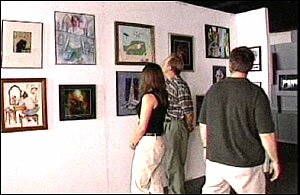
Fourth Migraine Masterpieces exhibition held in Chicago the week of July 21, 2003. © 2004 National Headache Foundation (http://www.9news.com/storyfull-daybreak.asp?id=16988, June 5, 2004)
|
You have been a participant in one of the four Migraine Masterpieces competitions? |
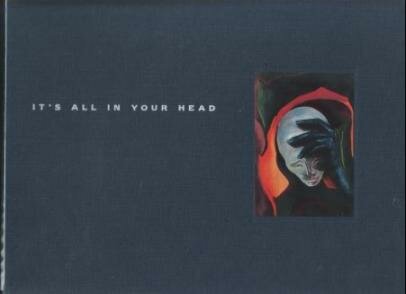
It's All in Your Head. Booklet with 44 slides produced by Sandoz Pharmaceuticals Corporation, 1991. © 2004 Novartis
In 1989, Dr Egilius L.H. Spierings from the Headache Research Foundation and Graham Headache Centre at Boston's Faulkner Hospital and Sandoz Pharmaceuticals Corporation (now part of Novartis) organized a "headache-art" competition in New England, United States.
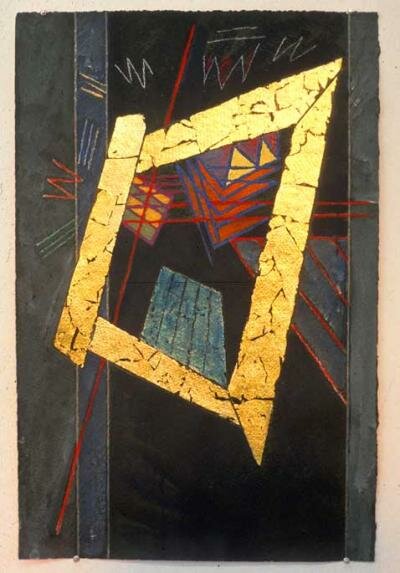
Philipp Morse, Headache I, 1989. (Entry to the 1989 "headache-art" contest.) © 2004 Philipp Morse
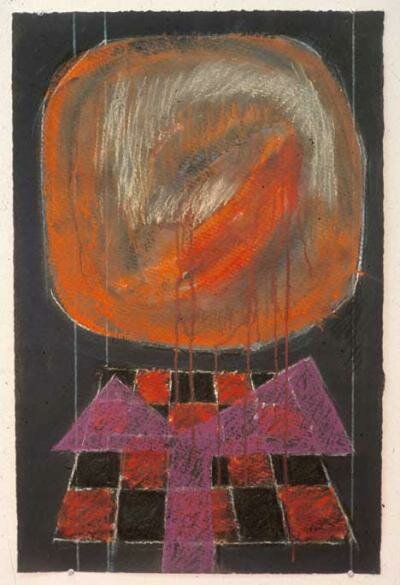
Philipp Morse, Headache II (Thunderhead), 1989. (Entry to the 1989 "headache-art" contest.) © 2004 Novartis
|
Philipp Morse had "submitted two paintings... I was using metallic leaf for other images I was working on and because the glare sometimes hurt my eyes, it seemed like a natural way to express the visual sensitivity to light that goes along with a migraine..." (Email to Klaus Podoll, September 28, 2002) |
The idea of "headache-art" was derived from Derek Robinson's concept of Migraine Art which had been presented to the American public in the 1987 exhibition in Boston, but the approach was extended purposefully from migraine to headaches in general. The "headache-art" contest produced more than 200 entries which formed the basis of the John R. Graham Headache Art Exhibition "Through the Looking Glass" at the Museum of Fine Arts in Boston, referring, of course, to the title of Lewis Carroll's second Alice book. The top 20 or so entries to the "headache-art" competition were subsequently used for touring exhibitions, their success being considered as "overwhelming".
|
You have been a participant in the 1989 "headache-art" contest "Through the Looking Glass"? |
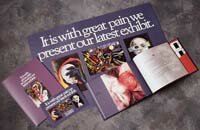
Promotional materials by Novartis from the "headache-art" contest 1989. © 2004 Novartis, September 24, 2002.
Sometimes Art Is the Best MedicineBy Joan Bachenheimer"Seek care." These words were central to helping Novartis, the world's leader in headache therapy, prevail against its first competition in decades. A simple call to action, they also formed the cornerstone of a landmark public education initiative designed to legitimize severe headache as a bona fide illness. The centerpiece: a touring exhibit of headache-inspired art created by sufferers themselves. Championed by former surgeon general C. Everett Koop, MD, the exhibit traveled to 100 cities in a four-year tour de force that generated coast-to-coast media coverage. The recipient of 15 prestigious awards, this campaign underscores that by exercising leadership in public education, pharmaceutical companies can indeed do well by doing good. In the words of the judges, the headache art campaign was "a 'big idea' in every sense and an exemplary PR program rich with results for the client." Moreover, this landmark campaign supported Novartis' key marketing goals: it drove previously untreated sufferers to see doctors and forged lasting ties with physicians for Novartis. Joan Bachenheimer, Brand Faceting: A Gem of a Marketing Idea. Developing an effective branding campaign lays the foundation for successful sales. Originally published June 2000 by MX (formerly Medical Device Executive Portfolio). (From medicaldevicelink, September 24, 2002) |
The "Through the Looking Glass" Headache Art Program - A Healthcare Public Relations Textbook StudyJim Weinrebe, now Senior Vice President of Schwartz Communications, "has led campaigns to generate headlines and condition markets for medical advances still in development, infused mature product lines with dynamic visibility, and launched new innovations to drive sales and market leadership. He has placed clients' medical breakthroughs in dozens of high-level consumer and business media, including BusinessWeek, The Wall Street Journal, ABC World News Tonight, CNN, USA Today and The New York Times. The 'Through the Looking Glass' headache art program Jim spearheaded to promote migraine awareness for Novartis has become a healthcare public relations textbook study." (Schwartz Communications, http://www.schwartz-pr.com/mngmt_l2.php?l2_id=55&id=68, May 25, 2004) |

Entry to art contest Migraine Images, 1992. © 2004 GlaxoSmithKline

Entry to art contest Migraine Images, 1992. © 2004 GlaxoSmithKline

Entry to art contest Migraine Images, 1992. © 2004 GlaxoSmithKline
In 1992, the Migraine Trust and Glaxo Pharmaceuticals (now GlaxoSmithKline) organized a contemporary art competition whereby UK artists were challenged "to portray the emotional and physical effects of migraine". During an exhibition entitled 'Migraine Images', 7th - 12th September 1992, a selection of the best competition entries was displayed at the St. Martin in the Fields Gallery in London, forming a part of the Migraine Trust's first Awareness Week designed to promote a better understanding of migraine in the public. Visitors to the exhibition agreed that "the artists have successfully portrayed the impact of an attack". The first prize was won by Chris Lock for her painting ‘Keeping Up Appearances’, the second prize by J.J. Ignatius Brennan for his ‘Migraine Man’ tryptich and the third by Elizabeth Strauss for her work ‘Head in Hands’. A selection of images from the 'Migraine Images' art contest can be found at www.rahmig.de/bilder.htm and www.migraine.co.nz/art.shtml.
|
You have been a participant in the 1992 "Migraine Images" art contest? |

Daniel Berkeland, Migraine Faces, oil on canvas (30" x 30"), 2002. (Entry to call for international artists suffering from migraine.) © 2004 Daniel Berkeland (http://www.danberkeland.com/indexthegalleries.html, September 20, 2002)
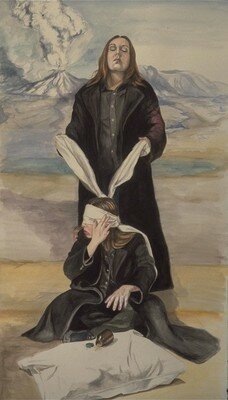
Rosemary Lucy Cosentino, Study for An Artist's Impediment to Create (Entry to call for international artists suffering from migraine), watercolour on Strathmore (circa 34" x 22"), 2002. © 2004 Rosemary Lucy Cosentino (Lost webpage http://www.rosemary-cosentino.com/images/ image54.jpg, August 19, 2002)
In 2002, the pharmaceutical company Pfizer Inc. commissioned Impact Unlimited to launch a call for international artists suffering from migraine which resulted in a selection of 14 pieces of Migraine Art used to support the promotional campaign for a new antimigraine medication. In contrast to the previously described art competitions for migraine sufferers, the process was not actually a contest. Rather, an international call to artists was sent out and the artists were commissioned to create pieces specifically for this project. They did not win a contest, they were hired for the commission. An internet gallery of this collection had been available at www.migrainerelief.com, but was removed lately.
References
Anonymous. Artists capture impact of a migraine attack. Gen Pract Weekly 1992; 44: 400.
Bachenheimer J. Brand Faceting: A Gem of a Marketing Idea. Developing an effective branding campaign lays the foundation for successful sales. MX (formerly Medical Device Executive Portfolio), June 2000.
Podoll K, Robinson D. Pictorial representations of macrosomatognosia experienced as somesthetic aura in migraine. Neurol Psychiat Brain Res 2003; 10: 125-128.
Rivenburg R. Missing Remotes and Migraine Masterpieces. Off-Kilter, February 14, 2001.
Vick RM, Sexton-Radek K. Interplay of art making practices and migraine headache pain experience. Headache Quart 1999; 10: 287-291.
Webb A. Pain as art. Exhibit depicts the violence of migraine headaches. American Medical News November 24, 1989; 32 (no. 44): 9.
Wickelgren I. Images of pain. Headache art lends a hand to science. Science News 1989; 136: 136-137.
Winter D. Portraits of pain: The art of headaches. Pharmaceutical Executive 1992; 12: 34-40.
Author: Klaus Podoll
Last modification of this page: Sat. Nov. 13 2004
| Migraine Art in the Internet |
 Top of the page
Top of the page| · | News |
| · | Medical Professionals |
| · | Medical Studies |
| · | Migraine Art Story |
| · | Migraine Art Exhibitions |
| · | The Migraine Art Concept |
Copyright © 2005 Migraine Aura Foundation, All rights reserved. Last modification of this site: August 25, 2006
Thanks to: RAFFELT MEDIENDESIGN and GNU software | webmaster@migraine-aura.org
http://migraine-aura.org/EN/Further_Competitions.html
